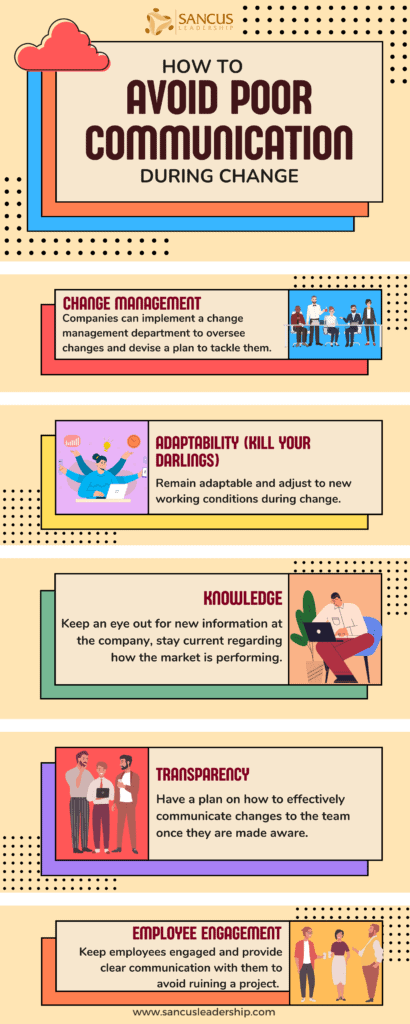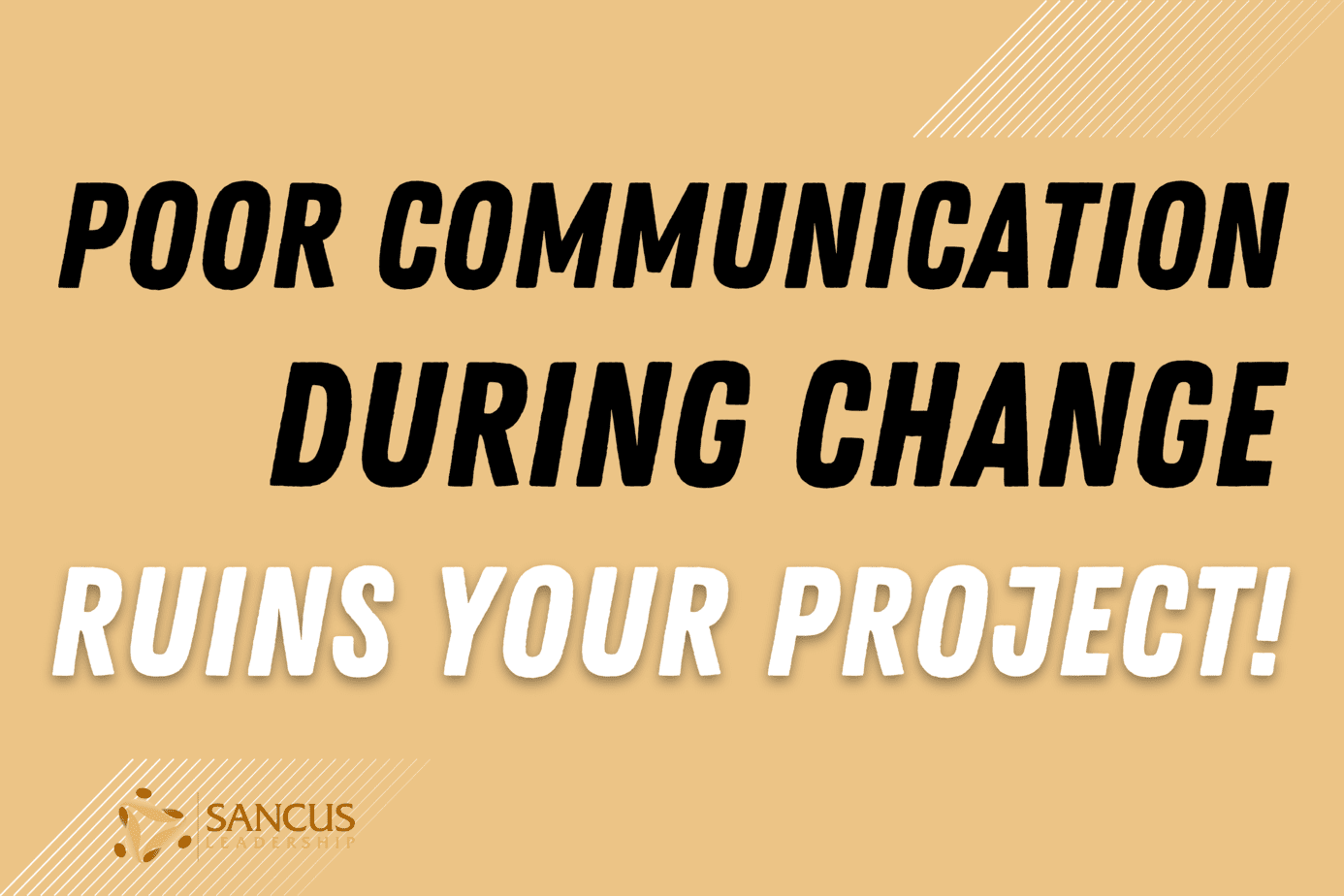If you are a leader or a manager, then you know communicating effectively is hard; getting what’s in your head into your teams is complex and even more so during a period of significant change. Through my 12 years as an army officer, I have learned that the source of the problem usually stems from needing a shared understanding of what exactly has changed. What was once common knowledge is no longer true, creating confusion, miscommunication, and subpar performance.
Poor communication during change leads to misunderstandings and misalignment. What used to be common knowledge and routine might no longer be valid and useful. If the impact of the changes is clearly communicated and understood, the project will save time redoing tasks and effective procedures.
This article will explore why poor communication during change will ruin your project and why clear communication is essential. It will also explain how you can stay up to date and how companies can communicate changes effectively for a smooth transition, so read on!
What is really the importance of language in small team leadership?
What Types of Changes Cause Poor Communication To Ruin a Project?

Companies undergo organizational and environmental changes, and poor communication during change can wreck projects.
Let’s discuss the different types of changes and how they can influence ongoing project work.
Organizational Changes That Impact Projects
Organizational changes can include but are not limited to the following.
- Management
- Policies
- Culture
- Strategy
Management
Management changes can throw off prioritization for projects.
When new management joins the company, communication is essential as it will influence a project’s success. You need to communicate why a project was initiated and provide evidence on why it should remain active and seen through to completion.
I have been through this many times, and probably so have you. In steps the new manager, and suddenly, everything has to change: priorities, goals, and procedures.
In my old company, we had a real issue with organizational knowledge; we struggled with experience being tied to a few key employees, which made the teams highly sensitive to change.
When the organization is good at writing and adhering to SOPs, the impact of the new management is usually more balanced. The pendulum swings less.
Policies
Policies and procedures can also change at a company.
For example, policies can be put in place on specific new laws and regulations that affect the procedures of a project already underway. Changes in internal policies can also affect the implementation of projects, especially if the project has already been initiated.
Clarify which guidelines will be followed until the project is completed — the old or new — and whether the project needs to be restarted.
This is a two-edged sword, change is unstoppable, and leaders to innovation and progress, but too much too fast is a recipe for losing control and direction. As soldiers, we always complained about the gear we had access to and the equipment we didn’t. This is just a soldier’s life 🙂
But the irony was that once new gear arrived, we would also quickly realize that we needed to be trained on that piece of kit. This means an initial regression in capacity which can hinder performance if it happens so often that you only have time to learn the skills once the following change happens.
Culture
Cultural changes in the workplace can also impact your project’s success or failure.
For example, new ways of working can be established and need to be appropriately communicated downstream to employees.
Your team may find out that the company only allows work in the office. Scheduling project meetings can become difficult if employees cannot work from home, delaying timelines.
Most cultural changes take years to accomplish, but one way we can be overwhelmed by a culture change is when working with other teams or businesses.
My old team was a six-man Bomb Disposal Team (EOD), and our main task was to attach to regular infantry units and help them remove bombs so they could have what is called “freedom of movement.”
Our team was highly autonomous with a somewhat flat hierarchy. The infantry, on the other hand, had a rigorous top-down culture. To best support them, we had to outwardly show that we could fit into a “top-down” culture, but internally we would operate just as we’ve always had.
Strategy
A change in strategy can have a significant impact on a project if changes are not communicated properly.
There is potential for completed work to go to waste, so ensuring a project pivots with an organization’s overall strategy is imperative. However, upper management may need to communicate upcoming strategy changes downstream, which can cause projects to go the wayside.
My experience is that strategy changes always mean a loss of effectiveness at the beginning stage; it takes a while for upper management to not only spread the information but also to learn how to present it in a way that the organization understands and accepts.
We had a ton of big changes during my time in the army; we went from Afghanistan to West Africa without someone ever really explaining what the differences were or what experiences still were valid and which should be thrown out.
This led to many stupid and unnecessary errors; lessons learned from Afghanistan were lost, and mistakes were repeated, but in another sandy country.
| Organizational Change | Impact on Projects |
| Management | It can disrupt project prioritization; communication is crucial to ensure new management understands the project and why it should continue. |
| Policies | Changes in policies and procedures can affect ongoing projects. It is necessary to clarify which guidelines will be followed until the project is completed. |
| Culture | Cultural changes can impact project success, such as new ways of working not being communicated effectively to downstream employees. |
| Strategy | A change in strategy can cause completed work to go to waste, and it is essential to pivot projects with the organization’s overall strategy, which needs to be communicated properly. |
Environmental Changes That Impact Projects
Environmental changes can include but are not limited to the following.
- Market
- Departmental
- Technology
- Resources
Market
The market has a significant impact on the overall working environment.
Changes should be communicated efficiently and promptly since the market can change direction anytime.
For example, a company may be looking to cut costs on various initiatives due to market instability, which will ruin a project if not communicated efficiently. Projects that anticipate a particular budget and then have to work with less may fail if they’re top-loaded in their expenses.
This is also the fun part of business; it’s a game of cat and mouse, trying to understand where the market is going and positioning ourselves in its way!
Departmental
There are also times when overall departments are restructured, which will impact an existing project.
Managers who are shifted around may no longer have your project on their list. Clear communication must occur regarding ongoing project work where resources have already been invested, including human resources. Project managers need to know what to prioritize to ensure that ongoing projects are given the attention they need.
In the EOD world, there is a principle called “one task, one team”; the assumption is that it’s too complicated and risky to hand over a task to someone else. The chance of failing to share all vital information or that the recipient doesn’t see it the same way as you did is too big.
This is a principle I like to recommend to the business world as well, let the “unit” finish its tasks or cancel the task. Don’t give it to someone else for completion; it will only lead to inefficiency and low morale.
Technology
Technology is constantly being updated, and organizations always look to change their platforms to the most up-to-date tools.
However, poor communication regarding technology changes can also ruin a project; therefore, a company should communicate the impact of any tech-related changes to its employees.
Timelines can be delayed, but a project can fail altogether if the project software is not accessible. Additionally, software changes will require a learning curve and training; if completed on time, it can save a project.
You should only implement updates at specific intervals, such as every quarter. Hold off on updates that impact users (unless they are Urgent and Important) until you are sure you can train your people to use them effectively. You must be in charge of implementations, not the software developers.
Resources
A team may also lose dedicated project resources, impacting project timelines if not communicated well downstream.
If a specific task or portion needs to be shifted to another individual, management must communicate this change immediately.
Companies can also change the work environment by outsourcing resources to manage expenses. However, this outsourcing can only save a project if a project’s details are communicated well or if you lose the proper expertise.
Transferring projects effectively is almost impossible if the task is creative or complex. You can transfer the assignment without significant losses if you have a strong SOP, a clear reporting system, and a straightforward task.
| Environmental Change | Impact on Projects | Communication Strategies |
| Market | Can change direction at any time and impact budgets | Communicate changes promptly and efficiently |
| Departmental | Restructuring can shift project priorities | Clear communication on ongoing projects and priorities |
| Technology | Updates can cause delays and require training | Implement updates at specific intervals and ensure effective training |
| Resources | Loss of dedicated resources can impact timelines | Communicate changes immediately and consider outsourcing carefully |
Why is Clear Communication Important During Change?

Clear communication is essential during change since when the “rules of the game” are transforming, so must also the business processes. All differences must be communicated clearly, whether a company is going through an organizational change or altering the work environment.
Deliverables
Clear communication is vital during change because it can impact deliverables.
Projects are often the source of how deliverables are met, and if changes are communicated properly, they can ensure company goals are met.
It is especially important to keep in mind the deliverables promised to external clients. Any delays should be communicated properly to project holders and clients to prevent them from leaving for another competitor.
A great communicator can convert the necessary changes from something negative into an added benefit for the client.
A great communicator can convert the necessary changes from something negative into an added benefit for the client.
Clients
Speaking of clients, they are an incredibly essential part of why clear communication is important during change.
You do not want to lose clients and money because of poor communication on a project deliverable.
Clear communication within a company, especially during times of change, demonstrate stability to an outside client.
Clients trust those companies whose behavior and deliverables they can anticipate; it’s better to deliver in a way that allows your clients to plan their business, even if that means aiming a little lower.
Deliver what is promised every time, and overdeliver whenever you can!
Deliver what is promised every time, and overdeliver whenever you can!
Funding
As a manager, you want to ensure you communicate clearly about projects to senior leaders during change because this can impact funding.
Funding is vital to a project’s success; clear communication about the needs and requirements is vital. You do not want to discuss an ongoing project too late and find out that funding for it has been discontinued or will be delayed.
Employee Well-Being
Employee well-being can be affected by poor or clear communication at a company.
Employee well-being can be affected by poor or clear communication at a company.
Employees want to stay in the loop about changes that impact their work. If they feel that they are being disregarded or intentionally not informed about changes, this can influence projects to be completed successfully and on time.
Employees may also think about leaving a company if poor communication continues during organizational change, especially if changes often occur at that company.
In my opinion, it’s a difficult balance between sharing too much and sharing too little. Communicate too little, and your people will feel like they are being kept in the dark, but on the other hand, sharing everything will, in my experience, only make people feel overwhelmed and unnecessarily worried.
In my last team, I had one guy who wanted to know every little detail of information that came from above. But I also had a guy who didn’t give a crap and only wanted information directly related to his work.
It’s your job as the manager or leader to understand your team so that you can communicate to them in a way that they can focus on the task and also understand the bigger picture.
What Are the Consequences of Poor Communication During Change?

Employees can face unintentional repercussions when there is constant poor communication from the top.
There are additional consequences of poor communication during change aside from destroying your project, including the loss of the following.
- Employee morale
- Employee headcount
- Employee engagement
- Employee feedback
If change is not communicated properly at a company, then you can expect employee morale to go down. This reduction in morale may lead to high turnover rates.
Internal employee issues can also lead to a tarnished company reputation, and it will make it harder to recruit new talent.
For the employees who choose to stay, engagement in projects may be reduced if they know there is instability and a lack of communication that is often occurring at the company.
Employees are also less likely to provide feedback about changes if they know they are not being heard or if their feedback is never incorporated into decision-making.
Additionally, projects are not the only thing being compromised, as poor communication during change can also affect the day-to-day workload.
Poor communication can hinder an organization’s daily operations, resulting in delayed or failed results if employees are no longer motivated to perform their best.
Poor communication can hinder an organization’s daily operations, resulting in delayed or failed results if employees are no longer motivated to perform their best.
You can count on creativity to go away and on new ideas to no longer be provided, and as a result, the company may no longer be seen as a leader in its industry.
The stakes are high regarding poor communication during change, whether a project is ruined or something else is lost.
Here is a short video talking about how an effective change communication strategy is essential to successfully orchestrate any change envisaged by leadership.
How To Avoid Poor Communication During Change
There are several ways to avoid ruining a project due to poor communication, including but not limited to the following.
- Change management
- Adaptability
- Knowledge
- Transparency
- Employee Engagement
Change Management
Many companies have now implemented a change management department, overseeing changes that can impact internal processes.
Change management, an integral part of project management, helps companies devise a plan to tackle a change. It includes open communication with all teams involved.
This kind of communication and discussion helps teams to bring up any projects or work that can be affected by a specific change and creates an open dialogue upfront.
To be honest, I have never worked in a place that had a functioning change management system; it most often was some “consult know-it-all” coming in to deliver the “truth.” I like the idea, but I haven’t seen it implemented in an effective way yet.
Adaptability (Kill Your Darlings)
Another way to avoid ruining a project due to poor communication during change is to remain adaptable.
Adjusting to new working conditions during change at a company can help loosen the burden of a project no longer being required or project resources reallocated.
You may also just have to adjust a project’s target or focus, so remaining flexible so you can easily do so is key.
Be prepared that not all changes occurring at an organization are going to be communicated clearly and promptly. Therefore, it is important to adjust your mindset regarding a project so that you can pivot easily if necessary.
In writing, it is sometimes referred to as “killing your darlings” when you remove a piece of text you like, but that doesn’t add value to the reader (the writer’s client). It’s important for us leaders to “kill our darlings”; every project, task, or commitment that no longer helps us reach our goals must die.
So when the situation changes, be prepared to kick some of those tasks into the spartan hole (you know, “this is Sparta.”;)).
So when the situation changes, be prepared to kick some of those tasks into the spartan hole (you know, “this is Sparta.”).
Knowledge
Keeping an eye out for new information at your company, whether it is communicated to you formally or informally, is also a great way to stay informed about changes.
Be attentive to surroundings when change occurs, such as new management visits or onsite meetings, as this can provide clues as to what’s coming.
Also, you should stay current regarding items like how the market is performing since extremes usually bring about change in an organization.
Asking questions and remaining vigilant about project updates in meetings is also important in case unexpected changes occur.
We used to go through all the folders of the internal network and see if we could find some clues to what might be in the making, this was actually very beneficial, and it almost became a sport trying to find the best info so we could stay prepared for the following change.
Maybe this is the result of working with intelligence officers. 🙂
Transparency
Lack of transparency also contributes to poor communication and ruined projects.
People leaders should have a plan on how to effectively communicate changes to their team once they are made aware. This plan will allow team members to voice any concerns or opinions that may help decision-making.
Also, such a plan will allow a leader to come up with a plan on how to execute a change without it having too much of a negative impact on an ongoing project.
Employee Engagement
Keeping your employees engaged is also key to not ruining a project while changes occur at a company.
Usually, the people involved firsthand in a project see the most impact, so clear communication with them is crucial.
Employees can provide insights that managers may not see; keeping them in the loop will help avoid ruining a project.
A big change is never an easy thing to go through at any company, but clear communication and employee engagement can ease the burden and answer a lot of questions.
| Communication Strategy | Description |
| Change Management | Companies can implement a change management department to oversee changes and devise a plan to tackle them, including open communication with all teams involved. |
| Adaptability (Kill Your Darlings) | Remain adaptable and adjust to new working conditions during change. Be prepared to adjust project targets or focus and remove tasks or commitments that no longer help reach goals. |
| Knowledge | Keep an eye out for new information at the company, stay current regarding how the market is performing, and ask questions to remain vigilant about project updates. |
| Transparency | Have a plan on how to effectively communicate changes to the team once they are made aware, allowing team members to voice concerns or opinions that may help decision-making. |
| Employee Engagement | Keep employees engaged and provide clear communication with them to avoid ruining a project. Employees can provide insights that managers may not see. |
How Should Change Be Properly Communicated at a Company?

Communicating change properly starts with the leaders at the top of an organization.
First, senior leaders need to be aware that any change is going to have some sort of impact on its employees. Therefore, clear communication about what, why, and how is key to a smooth transition.
Questions that should be addressed include the following.
- What changes is the company implementing?
- Why are the changes required?
- How will the changes be executed?
- How will the changes affect my department?
- What is the plan and timeline to complete the changes?
Leadership will get more support if people know why certain changes are taking place and the timeline of these changes.
Leadership will get more support if people know why certain changes are taking place and the timeline of these changes.
Also, if changes are communicated upfront, it will be easier to understand the impacts they will have on existing projects.

Conclusion
Organizational and environmental changes greatly impact projects if not communicated properly. Clear communication is essential to meet project deliverables and retain clients. It can impact overall project funding as well as employee well-being.
Implementing change management can help avoid running projects due to poor communication. Transparency and adaptability to a changing work environment are also key. Leaders should be aware of the impact poor communication can have on their organization, therefore, prioritizing communication plans for its best interest.



